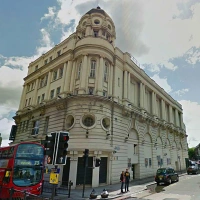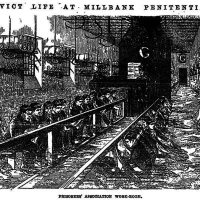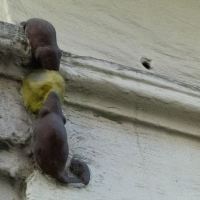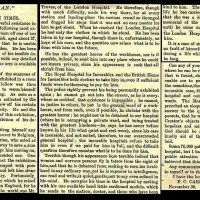Situated deep in the heart of St James’s and frequently overlooked by the crowds dashing between Regent Street and Horse Guards Parade, is this tiny gravestone:
The stone, preserved in its own miniature housing since the 1990s, is a wee memorial to ‘Giro’; an Alsatian dog who, as the German quotation on his tombstone states was “a true companion”.
Giro was killed suddenly in 1934- when the daft mutt made the fatal mistake of chewing through a live electrical cable.
*
I first discovered this curiosity whilst studying the Knowledge of London.
Being so small, the landmark was an old favourite of the examiners who liked to throw us trainee cabbies by asking us to locate points of a more obscure nature! After some time, I eventually found it… Giro’s headstone is located on Carlton House Terrace, opposite one of London’s more civilised car-parks on Waterloo Place.
The covered headstone sits in a small, gated patch beneath a tree, between the Duke of York Column and a grand row of buildings on Carlton House Terrace:

Location of Giro’s Headstone (image: Google maps)
*
Giro is often unfairly referred to as the ‘Nazi Dog’; this stigma stemming from the fact that he belonged to Dr Leopold von Hoesch, the German ambassador to the United Kingdom from 1932 1936.
In those days, the German embassy was the building right next to Giro’s grave. (Today, the premises is home to the Royal Society).

The former German Embassy (which has since relocated to Belgrave Square)
Giro’s master was certainly no Nazi.
Dr Leopold von Hoesch was a respected statesman who did much to improve relations between Britain and Germany.
When he first came to Britain, it was as a representative of Germany’s Weimar Republic; the liberal, culturally progressive government which ruled Germany for a time between the two world-wars.

Herr Hoesch in the early 1930s
Tragically, the peaceful Weimar government was short-lived.
Following the Wall Street Crash in 1929, the world found itself in the grip of the Great Depression. In Germany this, along with hyper-inflation and unrest from various political groups, enabled Adolf Hitler to get a jackboot into the door of power in 1933.
Within days of Hitler managing to secure the position of Chancellor, Germany’s parliament building was ‘mysteriously’ set ablaze in the infamous Reichstag Fire.
Seizing upon this convenient disaster and warning of civil unrest, Hitler immediately passed an emergency powers act, granting his government the power to strip German citizens of their liberties indefinitely… a useful thing when you want to crush your opponents and destroy certain groups…

Crowds watch the Reichstag burn in 1933…
Back in London, Dr Hoesch, who had been dubious of Hitler and the Nazis from the offset, viewed the rapid take over with dismay.
He wasted no time in challenging Hitler, sending messages back to Germany about his distrust of the dubious characters in the Fuhrer’s entourage who had muscled in on the government- one of whom was Von Ribbentrop, a character whom Dr Hoesch found particularly distasteful.
Over the next few years, Hitler would be greatly vexed by his ambassador in Britain.
Things came to a head In March 1936 when Hitler invaded the Rhineland. Dr Hoesch denounced the action, accusing the Fuhrer of deliberately provoking France and Britain- a rare voice of dissent against a figure whom many now feared to confront.
Tragically, Dr Hoesch died of a heart attack less than a month later.
He passed away inside the German embassy itself and, aged just 55, it is generally believed that the attack was brought on from the stress caused by dealing with his homeland’s turbulent leadership.

Herr Hoesch… the statesman who challenged the Nazis right up until his untimely death
Thanks to the respect which the British had for the ambassador who had been a thorn in the Fuhrer’s side, Dr Hoesch was granted a grand funeral parade and gun-salute before being shipped back to his homeland.
By this time of course, the traditional German flag had been replaced with the notorious red, white and black swastika insignia and it was this therefore this banner- which represented an ideology Dr Hoesch had never embraced- that had to be draped over the ambassador’s coffin; something which would no doubt have turned his stomach.
This funeral procession therefore represented a thankfully extremely rare occurrence- the only time that the dreaded symbol of Nazism had been so openly paraded on London’s streets- and so close to Buckingham Palace too.
The following clip is a newsreel depicting the event:
*
Now that the troublesome Dr Hoesch was out of the way, Hitler was free to cart a new representative off to London; one who was a true Nazi… Joachim Von Ribbentrop; Dr Hoesch’s nemesis and the man whom he’d voiced such distrust of when the Nazis first came to power.

Von Ribbentrop
A vain, arrogant man, Ribbentrop immediately set to work ‘Nazifying’ the German embassy; altering the interior to bring its appearance more in line with the twisted ideology. This task was granted to Albert Speer, one of the Nazi’s most trusted architects.
A grand staircase was installed- created from marble donated by Benito Mussolini, and rumours still abound that a swastika mosaic (apparently now covered over) was laid upon the floor of one particular room.
Ribbentrop’s time in London would not last for very long. Three years later, the darkness of war, bombs and hatred had returned to Europe and he was promptly dismissed.
Somehow, however the little gravestone of Giro, Dr Hoesch’s faithful friend survived WWII… saved by a mixture of obscurity and respect for the man who had so strongly opposed his Nazi masters.

Herr Hoesch on Carlton Terrace… in happier times with his beloved dogs














A fascinating story – particularly for me as I had relatives in Germany during the 1930s and Second World War who also opposed the Nazis and the war. I shall check out the grave
Thanks for the kind comments, Nicola that means a lot to me, especially considering your family’s history. Thank you also for following my blog- just discovered yours too, your photography is superb.
Thanks again.
A question for you. Do you know what happened to the ambassa wife? I do.
I don’t, no… would be very interested to find out 🙂
As the story was told to me by relatives, the wife of Leopold was Jewish. My grandfather was her brother. My grandfather came to the United States in 1906. His sister (Anna) and brother, Jakob remained in Germany. Even after the takeover of Germany, Leopold (as you know) remained the Ambassador to the UK. Being popular and somewhat influential, he was never bothered by the Nazi’s. After his death however, things changed. Anna went back to the “landhaus” in the town of Bishofsheim (between Fulda and Wurzburg) whee the family lived. I personally have been there on many occasions visiting the son and grandson of Leopold. The son, Herbert (my dad’s first cousin) was an exceptionall person. Had a wonderful sense of humor. Anyway, during the war, the Gestapo came to the Landhaus for Anna. She committed suicide at the top of the stairs as the Gestapo were waiting for her.
Additional fascinating stories about Herbert and the brother of Anna.
I don’t know if anyone will respond, but it is very interesting to read this story about someone I have only recently learned I am distantly related to. My great-grandparents immigrated to the states before the first world war, but they kept in contact with friends and relatives back in Germany. My great uncle was a missionary to Africa during the second world war, and often wrote letters to relatives asking who he may pray for, never minding if they toed the line with party beliefs or not. I’ve actually read a handful of these letters as my grandparents (being children of the great depression) never threw anything away.
Thank you so much Thomas. I have sent you an email.
My name is Bruce Feldhammer and live in San Francisco.
Thomas, I am the granddaughter of Adolf Feldhammer, (first cousin to Bruce, above), who was brother to Anna, Bruno, Jakob, Rosa
I have recently sent in the FamilytreeDNA info to find other relatives.
We are obviously related–through the Feldhammer line.
You can contact me through Karen Franklin, genealogist to Alan Rothenberg, another of our cousins.
Karenfrankln@gmail.com
Hope to hear from you–more stories to tell.
Beth Eiselman